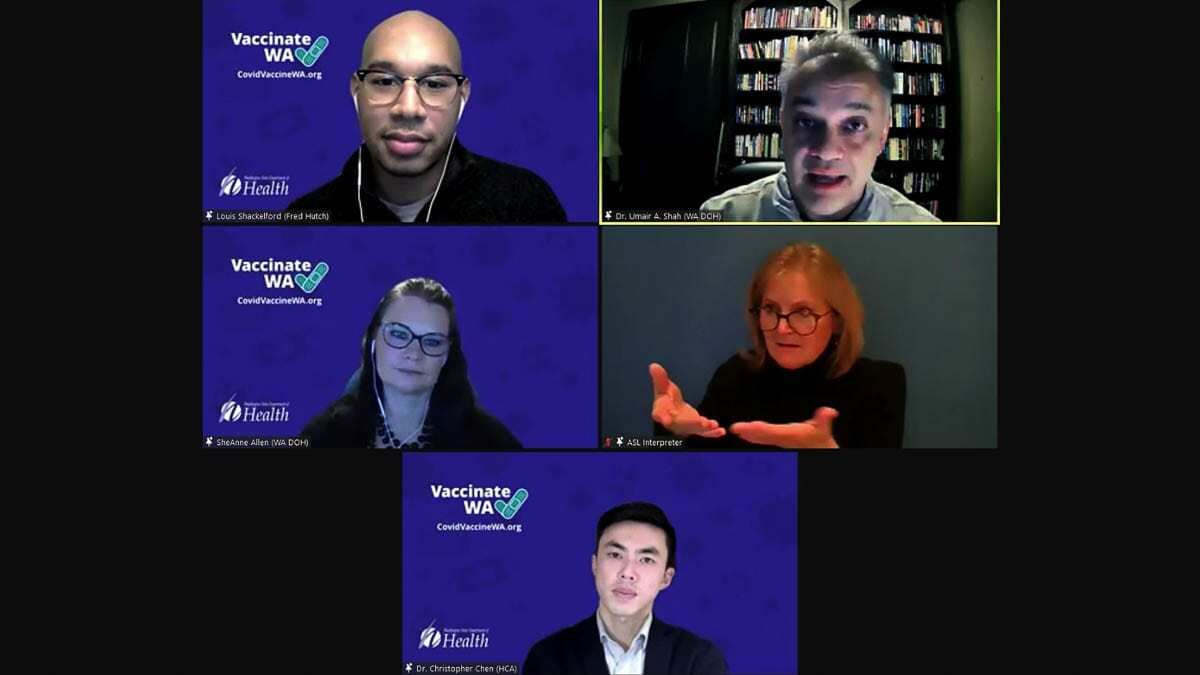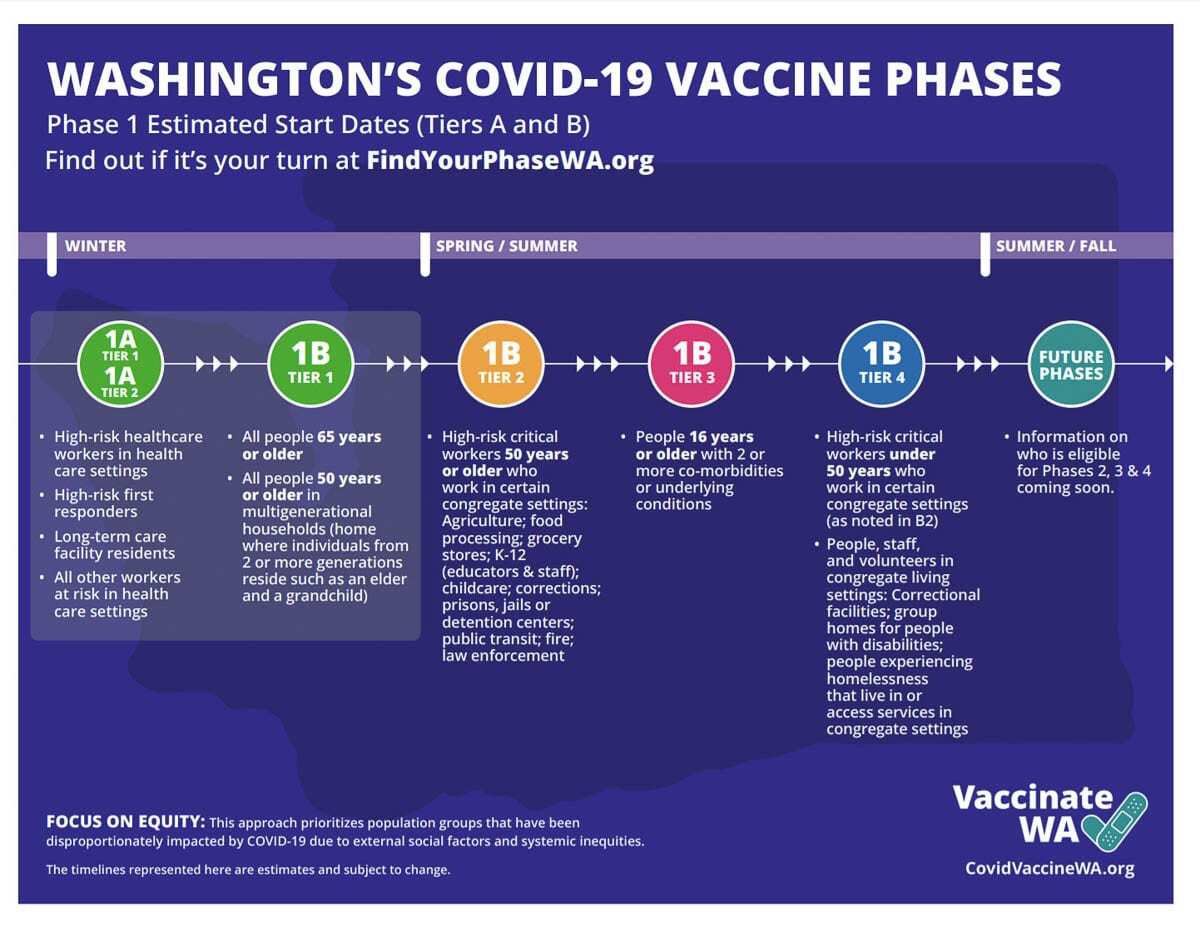Over 800 people submitted questions ahead of the online event
More than 800 questions were submitted ahead of a Washington Department of Health webinar on Thursday evening, during which state officials walked through the emerging COVID-19 vaccine rollout plan.

The webinar, hosted by Louis Shackelford, program director for the Fred Hutch HIV Vaccine Trials Network and Operations Center, included Washington Secretary of Health Dr. Umair Shah, Sheanne Allen, COVID-19 vaccine director for the state, and Dr. Christopher Chen, medical director of Medicaid with the Washington Health Care Authority.
Topics included the seemingly slow ramp up of vaccine availability, with many in the current phases frustrated about a lack of appointments, and others wondering when they’ll be able to get in line.
“If you look back a year ago, and if we could have said that, in the state of Washington, we would be here in mid February and have had more than a million Washingtonians getting a vaccine dose,” said Shah, “we would have been quite impressed by that.”

Shah pointed to the increase in how quickly vaccines are being administered after shipment. As of this week, 89 percent of the vaccines received in the state had been put in an arm, up from less than 30 percent in mid-January.
But that increase, along with shipment delays because of bad weather around the country, delayed shipments this week, further exacerbating a problem with limited first dose availability as the state shifts to make sure people can get their second dose in a reasonable amount of time.
“The math isn’t working in our favor,” admitted Shah, when it comes to reaching their goal of 45,000 people being vaccinated per day. So far, the highest number the state has been able to reach was 26,000 daily vaccinations, on average.
But the infrastructure is there, the experts maintain, to immediately make sure increases in vaccine shipments translate into increases in doses being administered.
“We have over 1,200 providers or facilities enrolled in the program,” Allen said. “We’ve only been able to allocate to about 25 percent of those facilities each week, because of the lack of supply.”
Equity concerns addressed
The state has recently begun tracking data about race and ethnicity when it comes to vaccine distribution.
Hispanics, who make up 13.2 percent of the state’s population, made up just 5.9 percent of all vaccinations in the most recent analysis. Disparities also existed, but were less pronounced, amongst black populations.
The state has had more success reaching tribal communities. As sovereign nations, many have chosen to receive vaccine shipments from the state, and then allocate them how they see fit. That has helped to create more buy-in amongst the state’s Native American population, said Allen.
Shah added that their approach to equity doesn’t mean focusing limited supplies on minority populations.
“I don’t think it’s an either or,” Shah said. “There is no reason why you can’t go fast, and also do it equitably.”
To accomplish that, Shah said the work of DOH is primarily to get local health departments and trusted community leaders on board to help marginalized groups know where to get the vaccine, and why they should.
“We know that there are many communities across the state of Washington, and across the country that honestly have reasons to not trust,” said Shah. “I can say, ‘Hey, eat an apple a day.’ A lot of people say, ‘yeah, that Dr. Shah saying ‘eat an apple a day, I’m not gonna eat an apple a day.’ But if someone of a community that’s trusted, a faith leader, says ‘eat an apple a day,’ or in this case, take a vaccine that is going to help protect you against this horrible disease, we know that is going to make a difference.”
Allen said the state is also moving to set aside a certain number of appointments at the state’s mass vaccination sites for people calling in over the phone, understanding that there is a sizable amount of people, especially in the current phase, who lack internet access, or skills to use it well.
“Before, it was all done online,” she said, “and we know that that is not allowing for equitable access.”
Beware of scammers
One of the items stressed during the webinar was that COVID-19 vaccines currently are being provided at no expense. The federal government is buying the doses, while providers and insurance companies have agreed not to bill for office times or any treatment needed if someone experiences an adverse reaction to a dose.
“We have almost 2 million people on Medicaid in the state of Washington,” said Dr. Chen. “And we want to be sure that everyone who can get a vaccine gets a vaccine.”
Medicaid will even pay for transportation if you need help getting to a vaccine appointment, as well as interpretive services for people who don’t speak English.
“We want to make sure that we do everything we can, so that even for those for whom it’s hard to get to their appointment, that those needs are taken care of,” said Chen.
Providers may still collect insurance information, said Chen, in order to receive compensation for the visit, but if you receive a bill you need to contact the state to notify them.
“Even if you don’t have insurance providers are not allowed to refuse you based on your ability to pay,” said Chen. “And that’s no matter where you go to get the vaccine.”
Allen noted that 1.5 million have used the state’s Phase Finder tool, which asks a series of questions to determine what phase you’re eligible in, and even allows you to sign up to be notified when your phase arrives.
“Eighty-nine percent of those respondents said that they were planning on getting the vaccine when they become eligible,” Allen said. “And about 94 percent … provided us with their contact information so that we can notify them when they become eligible.”
Currently, the state expects vaccine allotments to increase steadily in the next several weeks, from 263,570 total doses next week, to 292,220 the week of March 7. The Food and Drug Administration could also provide Emergency Use Authorization to a one-dose vaccine from Johnson & Johnson, which would add to the supply.
This week, alone, providers requested close to half a million doses, indicating that there is plenty of capability to deliver those doses when they arrive. In the meantime, some continued patience will be required for anyone hoping to line up.
“We’ve had a very difficult 2020. I call that the first half of a very difficult football game,” said Shah. “First half didn’t go so well. And so we’re hopeful that we have a better second half here.”




